Business Resources Evaluation and Financial Analysis: Curry Lounge
VerifiedAdded on 2020/06/04
|10
|3007
|108
Report
AI Summary
This report provides a comprehensive analysis of Curry Lounge, a UK-based restaurant, examining various aspects of its business resources. The report begins by outlining the job description and required skills for customer service managers, including soft skills like communication and problem-solving, and desirable hard skills. It then explores employability skills and personal skills relevant to the business. The analysis extends to Curry Lounge's physical and technological resources, including security measures and software applications. The report further delves into the restaurant's financial strategies, detailing internal sources of finance like retained profit and personal savings, as well as external sources such as shareholders. A significant portion of the report is dedicated to analyzing the restaurant's Trading, Profit, and Loss account, highlighting key figures like turnover, cost of sales, and gross profit for the years 2014 and 2015. Finally, the report addresses sales and expense variances, providing insights into the restaurant's financial performance and challenges.
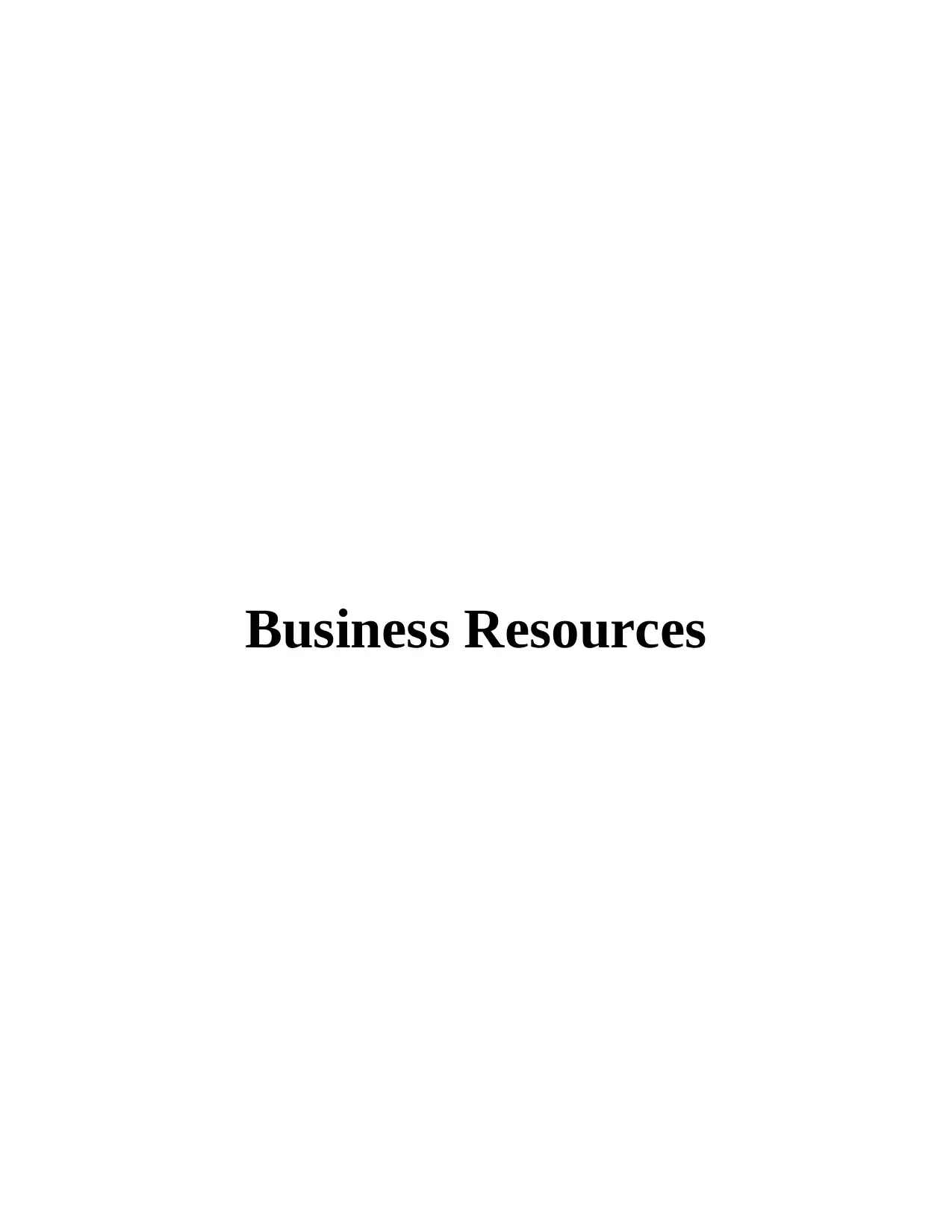
Business Resources
Paraphrase This Document
Need a fresh take? Get an instant paraphrase of this document with our AI Paraphraser
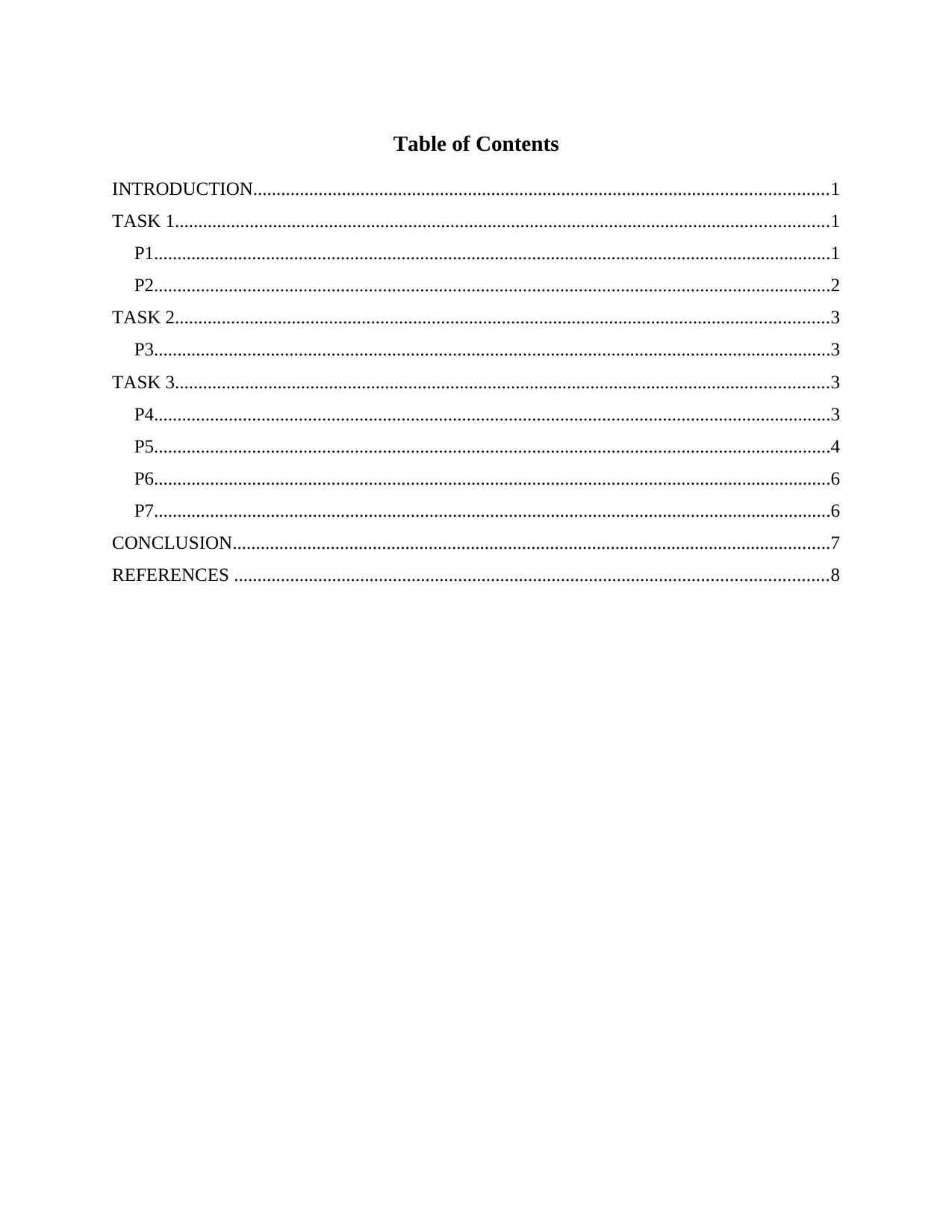
Table of Contents
INTRODUCTION...........................................................................................................................1
TASK 1............................................................................................................................................1
P1.................................................................................................................................................1
P2.................................................................................................................................................2
TASK 2............................................................................................................................................3
P3.................................................................................................................................................3
TASK 3............................................................................................................................................3
P4.................................................................................................................................................3
P5.................................................................................................................................................4
P6.................................................................................................................................................6
P7.................................................................................................................................................6
CONCLUSION................................................................................................................................7
REFERENCES ...............................................................................................................................8
INTRODUCTION...........................................................................................................................1
TASK 1............................................................................................................................................1
P1.................................................................................................................................................1
P2.................................................................................................................................................2
TASK 2............................................................................................................................................3
P3.................................................................................................................................................3
TASK 3............................................................................................................................................3
P4.................................................................................................................................................3
P5.................................................................................................................................................4
P6.................................................................................................................................................6
P7.................................................................................................................................................6
CONCLUSION................................................................................................................................7
REFERENCES ...............................................................................................................................8
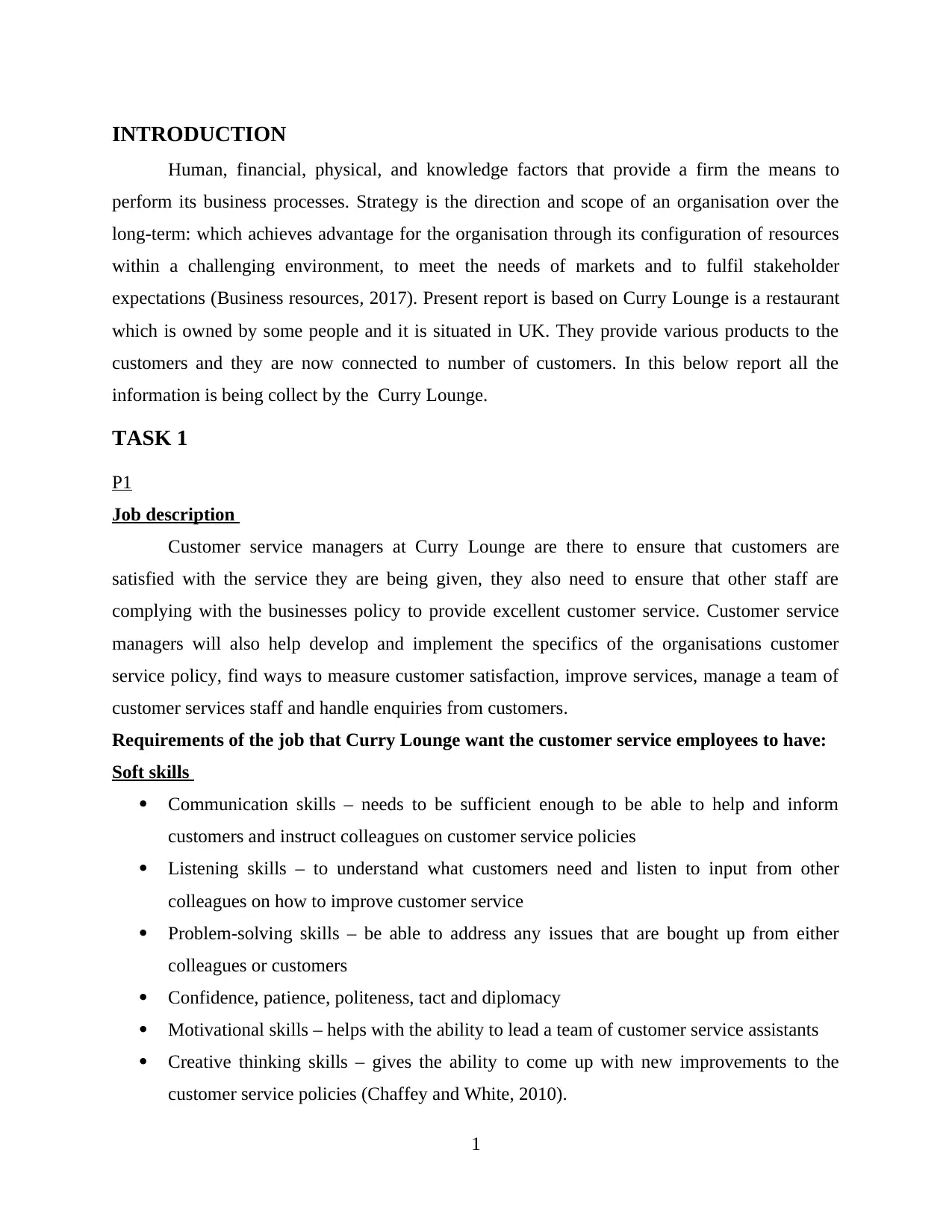
INTRODUCTION
Human, financial, physical, and knowledge factors that provide a firm the means to
perform its business processes. Strategy is the direction and scope of an organisation over the
long-term: which achieves advantage for the organisation through its configuration of resources
within a challenging environment, to meet the needs of markets and to fulfil stakeholder
expectations (Business resources, 2017). Present report is based on Curry Lounge is a restaurant
which is owned by some people and it is situated in UK. They provide various products to the
customers and they are now connected to number of customers. In this below report all the
information is being collect by the Curry Lounge.
TASK 1
P1
Job description
Customer service managers at Curry Lounge are there to ensure that customers are
satisfied with the service they are being given, they also need to ensure that other staff are
complying with the businesses policy to provide excellent customer service. Customer service
managers will also help develop and implement the specifics of the organisations customer
service policy, find ways to measure customer satisfaction, improve services, manage a team of
customer services staff and handle enquiries from customers.
Requirements of the job that Curry Lounge want the customer service employees to have:
Soft skills
Communication skills – needs to be sufficient enough to be able to help and inform
customers and instruct colleagues on customer service policies
Listening skills – to understand what customers need and listen to input from other
colleagues on how to improve customer service
Problem-solving skills – be able to address any issues that are bought up from either
colleagues or customers
Confidence, patience, politeness, tact and diplomacy
Motivational skills – helps with the ability to lead a team of customer service assistants
Creative thinking skills – gives the ability to come up with new improvements to the
customer service policies (Chaffey and White, 2010).
1
Human, financial, physical, and knowledge factors that provide a firm the means to
perform its business processes. Strategy is the direction and scope of an organisation over the
long-term: which achieves advantage for the organisation through its configuration of resources
within a challenging environment, to meet the needs of markets and to fulfil stakeholder
expectations (Business resources, 2017). Present report is based on Curry Lounge is a restaurant
which is owned by some people and it is situated in UK. They provide various products to the
customers and they are now connected to number of customers. In this below report all the
information is being collect by the Curry Lounge.
TASK 1
P1
Job description
Customer service managers at Curry Lounge are there to ensure that customers are
satisfied with the service they are being given, they also need to ensure that other staff are
complying with the businesses policy to provide excellent customer service. Customer service
managers will also help develop and implement the specifics of the organisations customer
service policy, find ways to measure customer satisfaction, improve services, manage a team of
customer services staff and handle enquiries from customers.
Requirements of the job that Curry Lounge want the customer service employees to have:
Soft skills
Communication skills – needs to be sufficient enough to be able to help and inform
customers and instruct colleagues on customer service policies
Listening skills – to understand what customers need and listen to input from other
colleagues on how to improve customer service
Problem-solving skills – be able to address any issues that are bought up from either
colleagues or customers
Confidence, patience, politeness, tact and diplomacy
Motivational skills – helps with the ability to lead a team of customer service assistants
Creative thinking skills – gives the ability to come up with new improvements to the
customer service policies (Chaffey and White, 2010).
1
⊘ This is a preview!⊘
Do you want full access?
Subscribe today to unlock all pages.

Trusted by 1+ million students worldwide
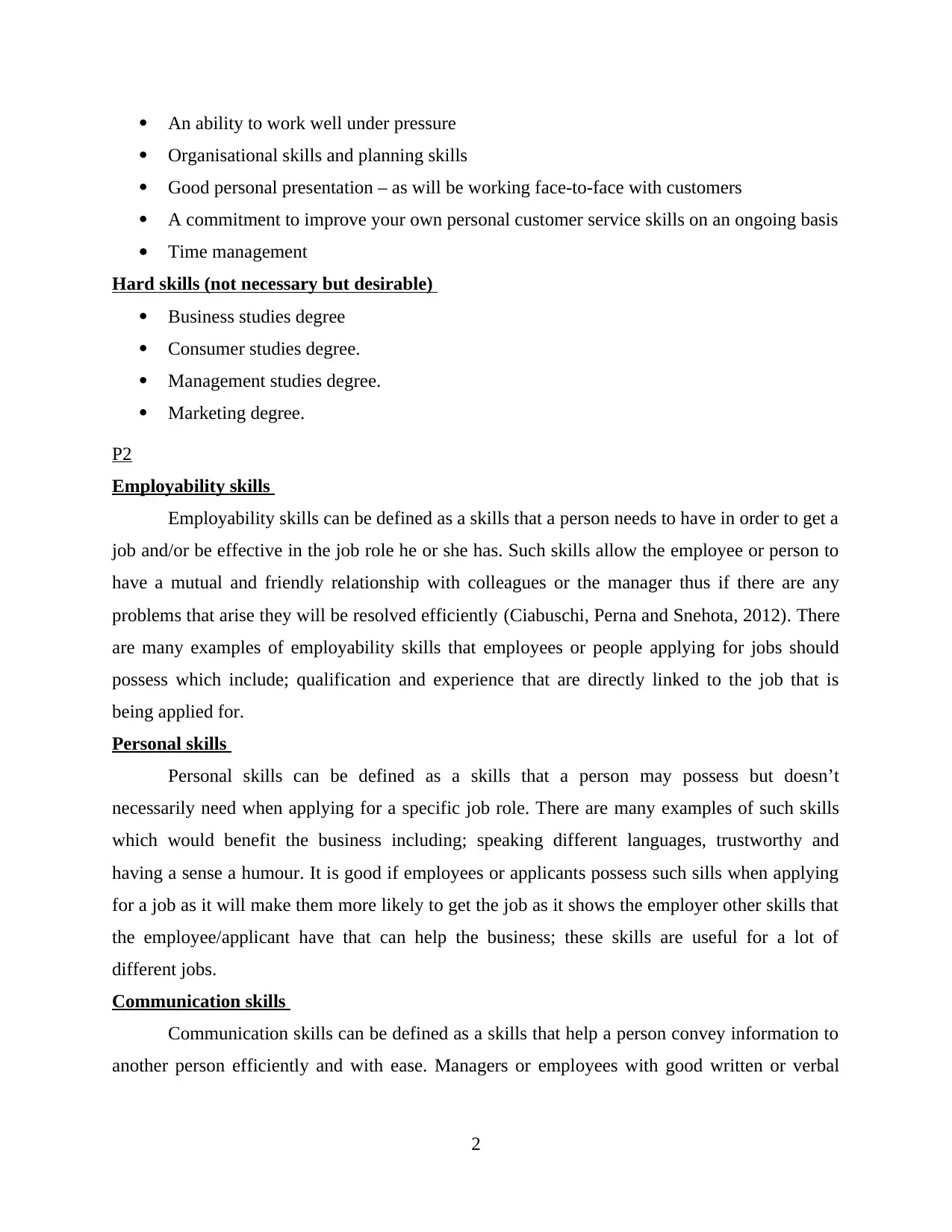
An ability to work well under pressure
Organisational skills and planning skills
Good personal presentation – as will be working face-to-face with customers
A commitment to improve your own personal customer service skills on an ongoing basis
Time management
Hard skills (not necessary but desirable)
Business studies degree
Consumer studies degree.
Management studies degree.
Marketing degree.
P2
Employability skills
Employability skills can be defined as a skills that a person needs to have in order to get a
job and/or be effective in the job role he or she has. Such skills allow the employee or person to
have a mutual and friendly relationship with colleagues or the manager thus if there are any
problems that arise they will be resolved efficiently (Ciabuschi, Perna and Snehota, 2012). There
are many examples of employability skills that employees or people applying for jobs should
possess which include; qualification and experience that are directly linked to the job that is
being applied for.
Personal skills
Personal skills can be defined as a skills that a person may possess but doesn’t
necessarily need when applying for a specific job role. There are many examples of such skills
which would benefit the business including; speaking different languages, trustworthy and
having a sense a humour. It is good if employees or applicants possess such sills when applying
for a job as it will make them more likely to get the job as it shows the employer other skills that
the employee/applicant have that can help the business; these skills are useful for a lot of
different jobs.
Communication skills
Communication skills can be defined as a skills that help a person convey information to
another person efficiently and with ease. Managers or employees with good written or verbal
2
Organisational skills and planning skills
Good personal presentation – as will be working face-to-face with customers
A commitment to improve your own personal customer service skills on an ongoing basis
Time management
Hard skills (not necessary but desirable)
Business studies degree
Consumer studies degree.
Management studies degree.
Marketing degree.
P2
Employability skills
Employability skills can be defined as a skills that a person needs to have in order to get a
job and/or be effective in the job role he or she has. Such skills allow the employee or person to
have a mutual and friendly relationship with colleagues or the manager thus if there are any
problems that arise they will be resolved efficiently (Ciabuschi, Perna and Snehota, 2012). There
are many examples of employability skills that employees or people applying for jobs should
possess which include; qualification and experience that are directly linked to the job that is
being applied for.
Personal skills
Personal skills can be defined as a skills that a person may possess but doesn’t
necessarily need when applying for a specific job role. There are many examples of such skills
which would benefit the business including; speaking different languages, trustworthy and
having a sense a humour. It is good if employees or applicants possess such sills when applying
for a job as it will make them more likely to get the job as it shows the employer other skills that
the employee/applicant have that can help the business; these skills are useful for a lot of
different jobs.
Communication skills
Communication skills can be defined as a skills that help a person convey information to
another person efficiently and with ease. Managers or employees with good written or verbal
2
Paraphrase This Document
Need a fresh take? Get an instant paraphrase of this document with our AI Paraphraser

communication skills will benefit the business; this is because they will be able to talk and
understand each other properly.
TASK 2
P3
Physical resources
At Curry Lounge the building they use is essential towards the day to day running of the
business. In order for the business to provide products and services to its customers they will
need different in-house resources to facilitate the smooth running of the business.
Security
Can be an issue for big companies like Curry Lounge, this is because people find it easier to steal
from big corporations than little independent shops, most Curry Lounge shops are open 24/7 so
they hire security staff that are there around the clock, Curry Lounge also uses security cameras
and security tags (on expensive or commonly stolen items) to facilitate the work of the security
guards (Hahn and Gold, 2014).
Technological resources
Curry Lounge uses software that is loaded on to all their technology. The software is the
programme that tells the technological items, like tills, what to do, it is loaded with all the
barcodes of items the store sells which means employees can quickly and easily scan items and
the tills will add it up with the least human labour possible.
Experience and skills are necessary for Curry Lounge to work as a business, skills are required
for the higher up jobs in the business such as management.
Intellectual property needs to be kept secret as it is required for Curry Lounge to ensure that
new ideas they come up with to improve the store will not be stolen and used in other competing
stores.
TASK 3
P4
Internal
Retained Profit can be defined as the amount of money that is left over when the all the
overhead and costs of business have been deducted. This is a good source of finance for Curry
Lounge to use as it is there for them to use and they don’t need to go to the bank or any other
3
understand each other properly.
TASK 2
P3
Physical resources
At Curry Lounge the building they use is essential towards the day to day running of the
business. In order for the business to provide products and services to its customers they will
need different in-house resources to facilitate the smooth running of the business.
Security
Can be an issue for big companies like Curry Lounge, this is because people find it easier to steal
from big corporations than little independent shops, most Curry Lounge shops are open 24/7 so
they hire security staff that are there around the clock, Curry Lounge also uses security cameras
and security tags (on expensive or commonly stolen items) to facilitate the work of the security
guards (Hahn and Gold, 2014).
Technological resources
Curry Lounge uses software that is loaded on to all their technology. The software is the
programme that tells the technological items, like tills, what to do, it is loaded with all the
barcodes of items the store sells which means employees can quickly and easily scan items and
the tills will add it up with the least human labour possible.
Experience and skills are necessary for Curry Lounge to work as a business, skills are required
for the higher up jobs in the business such as management.
Intellectual property needs to be kept secret as it is required for Curry Lounge to ensure that
new ideas they come up with to improve the store will not be stolen and used in other competing
stores.
TASK 3
P4
Internal
Retained Profit can be defined as the amount of money that is left over when the all the
overhead and costs of business have been deducted. This is a good source of finance for Curry
Lounge to use as it is there for them to use and they don’t need to go to the bank or any other
3
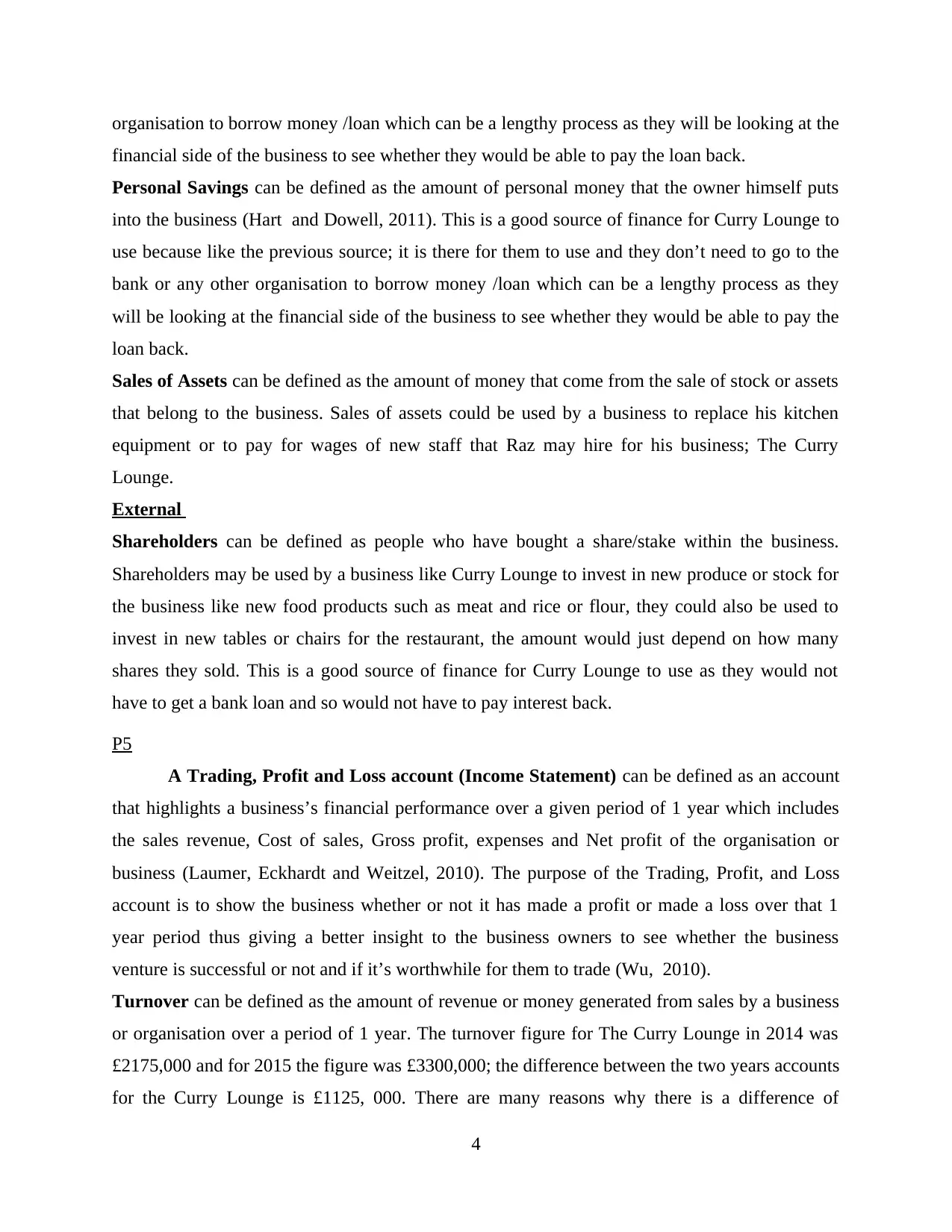
organisation to borrow money /loan which can be a lengthy process as they will be looking at the
financial side of the business to see whether they would be able to pay the loan back.
Personal Savings can be defined as the amount of personal money that the owner himself puts
into the business (Hart and Dowell, 2011). This is a good source of finance for Curry Lounge to
use because like the previous source; it is there for them to use and they don’t need to go to the
bank or any other organisation to borrow money /loan which can be a lengthy process as they
will be looking at the financial side of the business to see whether they would be able to pay the
loan back.
Sales of Assets can be defined as the amount of money that come from the sale of stock or assets
that belong to the business. Sales of assets could be used by a business to replace his kitchen
equipment or to pay for wages of new staff that Raz may hire for his business; The Curry
Lounge.
External
Shareholders can be defined as people who have bought a share/stake within the business.
Shareholders may be used by a business like Curry Lounge to invest in new produce or stock for
the business like new food products such as meat and rice or flour, they could also be used to
invest in new tables or chairs for the restaurant, the amount would just depend on how many
shares they sold. This is a good source of finance for Curry Lounge to use as they would not
have to get a bank loan and so would not have to pay interest back.
P5
A Trading, Profit and Loss account (Income Statement) can be defined as an account
that highlights a business’s financial performance over a given period of 1 year which includes
the sales revenue, Cost of sales, Gross profit, expenses and Net profit of the organisation or
business (Laumer, Eckhardt and Weitzel, 2010). The purpose of the Trading, Profit, and Loss
account is to show the business whether or not it has made a profit or made a loss over that 1
year period thus giving a better insight to the business owners to see whether the business
venture is successful or not and if it’s worthwhile for them to trade (Wu, 2010).
Turnover can be defined as the amount of revenue or money generated from sales by a business
or organisation over a period of 1 year. The turnover figure for The Curry Lounge in 2014 was
£2175,000 and for 2015 the figure was £3300,000; the difference between the two years accounts
for the Curry Lounge is £1125, 000. There are many reasons why there is a difference of
4
financial side of the business to see whether they would be able to pay the loan back.
Personal Savings can be defined as the amount of personal money that the owner himself puts
into the business (Hart and Dowell, 2011). This is a good source of finance for Curry Lounge to
use because like the previous source; it is there for them to use and they don’t need to go to the
bank or any other organisation to borrow money /loan which can be a lengthy process as they
will be looking at the financial side of the business to see whether they would be able to pay the
loan back.
Sales of Assets can be defined as the amount of money that come from the sale of stock or assets
that belong to the business. Sales of assets could be used by a business to replace his kitchen
equipment or to pay for wages of new staff that Raz may hire for his business; The Curry
Lounge.
External
Shareholders can be defined as people who have bought a share/stake within the business.
Shareholders may be used by a business like Curry Lounge to invest in new produce or stock for
the business like new food products such as meat and rice or flour, they could also be used to
invest in new tables or chairs for the restaurant, the amount would just depend on how many
shares they sold. This is a good source of finance for Curry Lounge to use as they would not
have to get a bank loan and so would not have to pay interest back.
P5
A Trading, Profit and Loss account (Income Statement) can be defined as an account
that highlights a business’s financial performance over a given period of 1 year which includes
the sales revenue, Cost of sales, Gross profit, expenses and Net profit of the organisation or
business (Laumer, Eckhardt and Weitzel, 2010). The purpose of the Trading, Profit, and Loss
account is to show the business whether or not it has made a profit or made a loss over that 1
year period thus giving a better insight to the business owners to see whether the business
venture is successful or not and if it’s worthwhile for them to trade (Wu, 2010).
Turnover can be defined as the amount of revenue or money generated from sales by a business
or organisation over a period of 1 year. The turnover figure for The Curry Lounge in 2014 was
£2175,000 and for 2015 the figure was £3300,000; the difference between the two years accounts
for the Curry Lounge is £1125, 000. There are many reasons why there is a difference of
4
⊘ This is a preview!⊘
Do you want full access?
Subscribe today to unlock all pages.

Trusted by 1+ million students worldwide
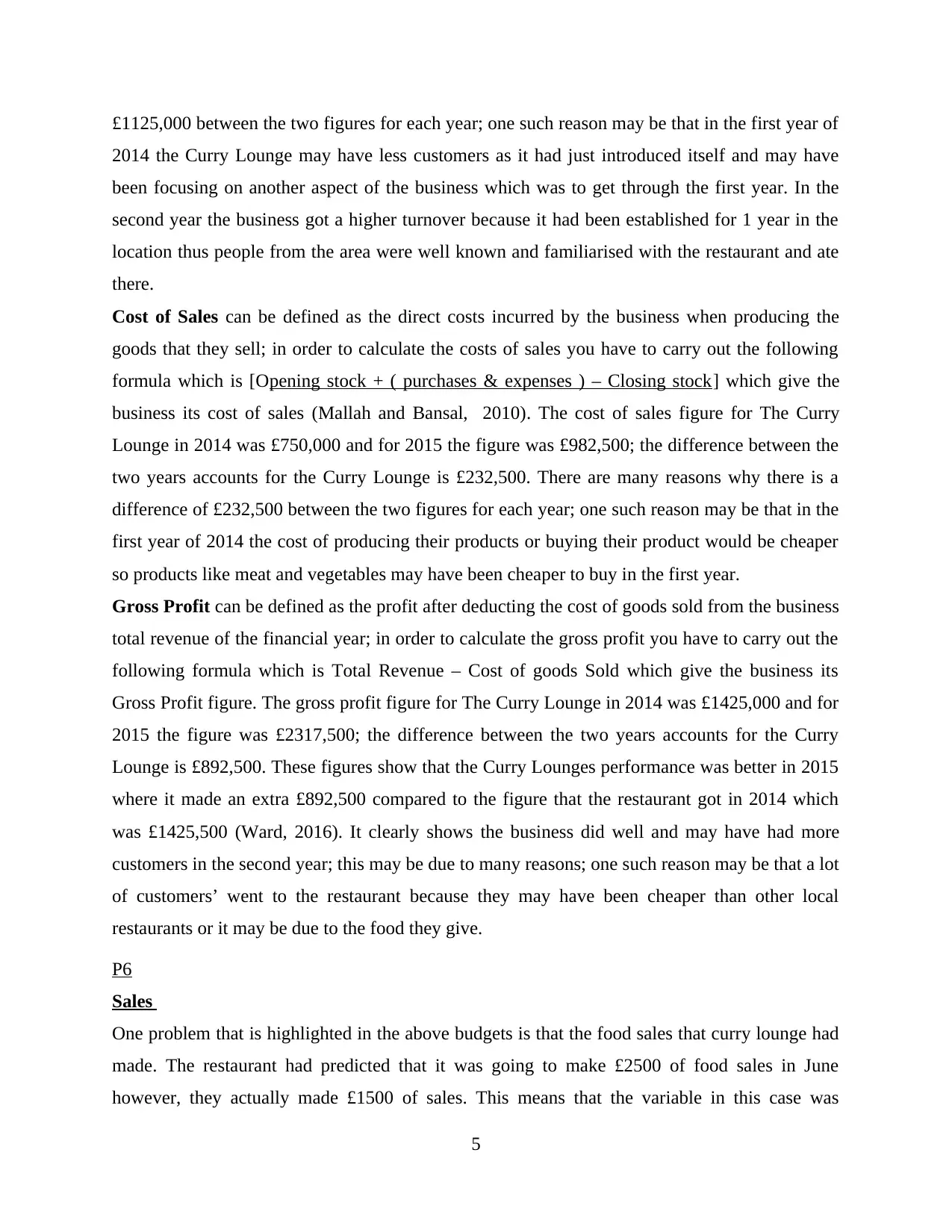
£1125,000 between the two figures for each year; one such reason may be that in the first year of
2014 the Curry Lounge may have less customers as it had just introduced itself and may have
been focusing on another aspect of the business which was to get through the first year. In the
second year the business got a higher turnover because it had been established for 1 year in the
location thus people from the area were well known and familiarised with the restaurant and ate
there.
Cost of Sales can be defined as the direct costs incurred by the business when producing the
goods that they sell; in order to calculate the costs of sales you have to carry out the following
formula which is [Opening stock + ( purchases & expenses ) – Closing stock] which give the
business its cost of sales (Mallah and Bansal, 2010). The cost of sales figure for The Curry
Lounge in 2014 was £750,000 and for 2015 the figure was £982,500; the difference between the
two years accounts for the Curry Lounge is £232,500. There are many reasons why there is a
difference of £232,500 between the two figures for each year; one such reason may be that in the
first year of 2014 the cost of producing their products or buying their product would be cheaper
so products like meat and vegetables may have been cheaper to buy in the first year.
Gross Profit can be defined as the profit after deducting the cost of goods sold from the business
total revenue of the financial year; in order to calculate the gross profit you have to carry out the
following formula which is Total Revenue – Cost of goods Sold which give the business its
Gross Profit figure. The gross profit figure for The Curry Lounge in 2014 was £1425,000 and for
2015 the figure was £2317,500; the difference between the two years accounts for the Curry
Lounge is £892,500. These figures show that the Curry Lounges performance was better in 2015
where it made an extra £892,500 compared to the figure that the restaurant got in 2014 which
was £1425,500 (Ward, 2016). It clearly shows the business did well and may have had more
customers in the second year; this may be due to many reasons; one such reason may be that a lot
of customers’ went to the restaurant because they may have been cheaper than other local
restaurants or it may be due to the food they give.
P6
Sales
One problem that is highlighted in the above budgets is that the food sales that curry lounge had
made. The restaurant had predicted that it was going to make £2500 of food sales in June
however, they actually made £1500 of sales. This means that the variable in this case was
5
2014 the Curry Lounge may have less customers as it had just introduced itself and may have
been focusing on another aspect of the business which was to get through the first year. In the
second year the business got a higher turnover because it had been established for 1 year in the
location thus people from the area were well known and familiarised with the restaurant and ate
there.
Cost of Sales can be defined as the direct costs incurred by the business when producing the
goods that they sell; in order to calculate the costs of sales you have to carry out the following
formula which is [Opening stock + ( purchases & expenses ) – Closing stock] which give the
business its cost of sales (Mallah and Bansal, 2010). The cost of sales figure for The Curry
Lounge in 2014 was £750,000 and for 2015 the figure was £982,500; the difference between the
two years accounts for the Curry Lounge is £232,500. There are many reasons why there is a
difference of £232,500 between the two figures for each year; one such reason may be that in the
first year of 2014 the cost of producing their products or buying their product would be cheaper
so products like meat and vegetables may have been cheaper to buy in the first year.
Gross Profit can be defined as the profit after deducting the cost of goods sold from the business
total revenue of the financial year; in order to calculate the gross profit you have to carry out the
following formula which is Total Revenue – Cost of goods Sold which give the business its
Gross Profit figure. The gross profit figure for The Curry Lounge in 2014 was £1425,000 and for
2015 the figure was £2317,500; the difference between the two years accounts for the Curry
Lounge is £892,500. These figures show that the Curry Lounges performance was better in 2015
where it made an extra £892,500 compared to the figure that the restaurant got in 2014 which
was £1425,500 (Ward, 2016). It clearly shows the business did well and may have had more
customers in the second year; this may be due to many reasons; one such reason may be that a lot
of customers’ went to the restaurant because they may have been cheaper than other local
restaurants or it may be due to the food they give.
P6
Sales
One problem that is highlighted in the above budgets is that the food sales that curry lounge had
made. The restaurant had predicted that it was going to make £2500 of food sales in June
however, they actually made £1500 of sales. This means that the variable in this case was
5
Paraphrase This Document
Need a fresh take? Get an instant paraphrase of this document with our AI Paraphraser
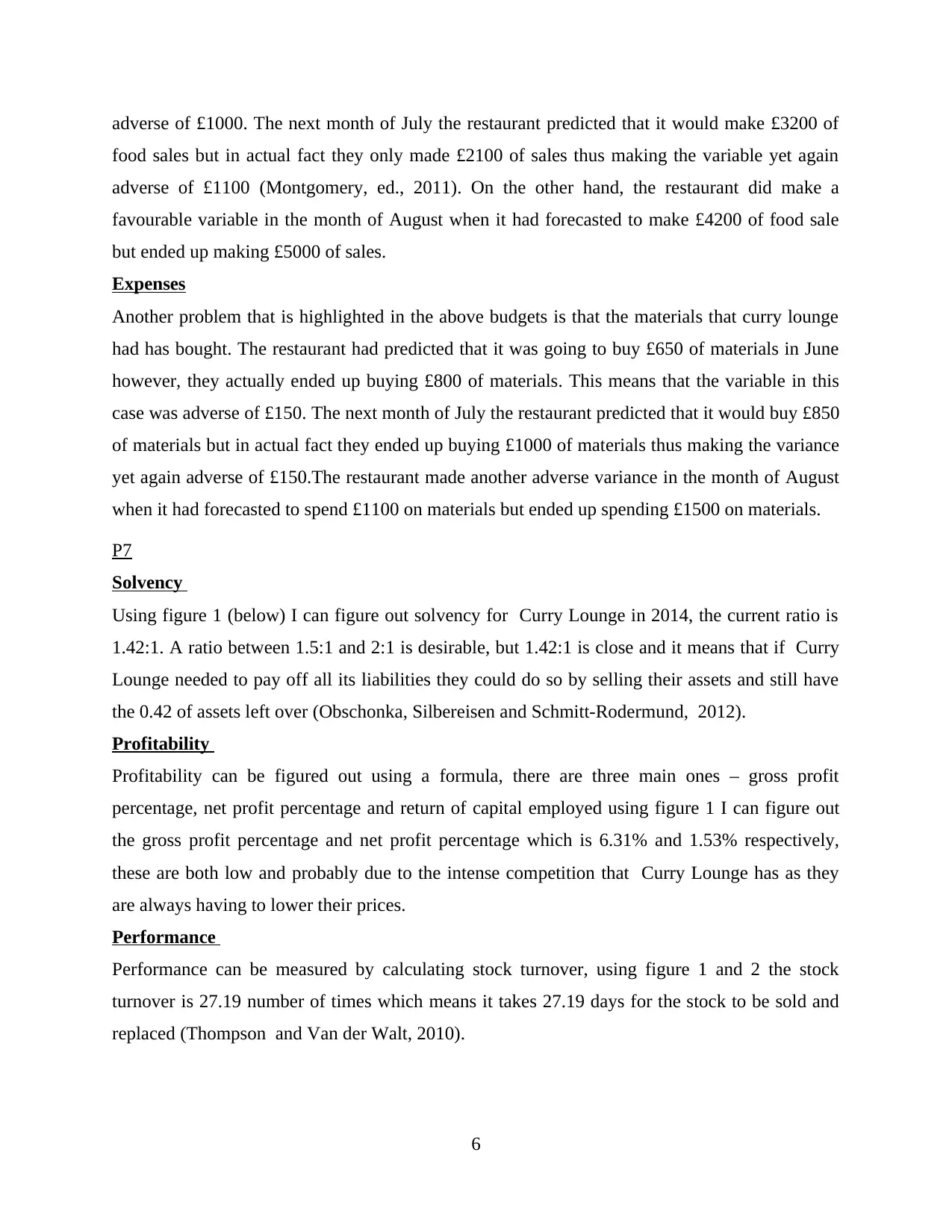
adverse of £1000. The next month of July the restaurant predicted that it would make £3200 of
food sales but in actual fact they only made £2100 of sales thus making the variable yet again
adverse of £1100 (Montgomery, ed., 2011). On the other hand, the restaurant did make a
favourable variable in the month of August when it had forecasted to make £4200 of food sale
but ended up making £5000 of sales.
Expenses
Another problem that is highlighted in the above budgets is that the materials that curry lounge
had has bought. The restaurant had predicted that it was going to buy £650 of materials in June
however, they actually ended up buying £800 of materials. This means that the variable in this
case was adverse of £150. The next month of July the restaurant predicted that it would buy £850
of materials but in actual fact they ended up buying £1000 of materials thus making the variance
yet again adverse of £150.The restaurant made another adverse variance in the month of August
when it had forecasted to spend £1100 on materials but ended up spending £1500 on materials.
P7
Solvency
Using figure 1 (below) I can figure out solvency for Curry Lounge in 2014, the current ratio is
1.42:1. A ratio between 1.5:1 and 2:1 is desirable, but 1.42:1 is close and it means that if Curry
Lounge needed to pay off all its liabilities they could do so by selling their assets and still have
the 0.42 of assets left over (Obschonka, Silbereisen and Schmitt‐Rodermund, 2012).
Profitability
Profitability can be figured out using a formula, there are three main ones – gross profit
percentage, net profit percentage and return of capital employed using figure 1 I can figure out
the gross profit percentage and net profit percentage which is 6.31% and 1.53% respectively,
these are both low and probably due to the intense competition that Curry Lounge has as they
are always having to lower their prices.
Performance
Performance can be measured by calculating stock turnover, using figure 1 and 2 the stock
turnover is 27.19 number of times which means it takes 27.19 days for the stock to be sold and
replaced (Thompson and Van der Walt, 2010).
6
food sales but in actual fact they only made £2100 of sales thus making the variable yet again
adverse of £1100 (Montgomery, ed., 2011). On the other hand, the restaurant did make a
favourable variable in the month of August when it had forecasted to make £4200 of food sale
but ended up making £5000 of sales.
Expenses
Another problem that is highlighted in the above budgets is that the materials that curry lounge
had has bought. The restaurant had predicted that it was going to buy £650 of materials in June
however, they actually ended up buying £800 of materials. This means that the variable in this
case was adverse of £150. The next month of July the restaurant predicted that it would buy £850
of materials but in actual fact they ended up buying £1000 of materials thus making the variance
yet again adverse of £150.The restaurant made another adverse variance in the month of August
when it had forecasted to spend £1100 on materials but ended up spending £1500 on materials.
P7
Solvency
Using figure 1 (below) I can figure out solvency for Curry Lounge in 2014, the current ratio is
1.42:1. A ratio between 1.5:1 and 2:1 is desirable, but 1.42:1 is close and it means that if Curry
Lounge needed to pay off all its liabilities they could do so by selling their assets and still have
the 0.42 of assets left over (Obschonka, Silbereisen and Schmitt‐Rodermund, 2012).
Profitability
Profitability can be figured out using a formula, there are three main ones – gross profit
percentage, net profit percentage and return of capital employed using figure 1 I can figure out
the gross profit percentage and net profit percentage which is 6.31% and 1.53% respectively,
these are both low and probably due to the intense competition that Curry Lounge has as they
are always having to lower their prices.
Performance
Performance can be measured by calculating stock turnover, using figure 1 and 2 the stock
turnover is 27.19 number of times which means it takes 27.19 days for the stock to be sold and
replaced (Thompson and Van der Walt, 2010).
6
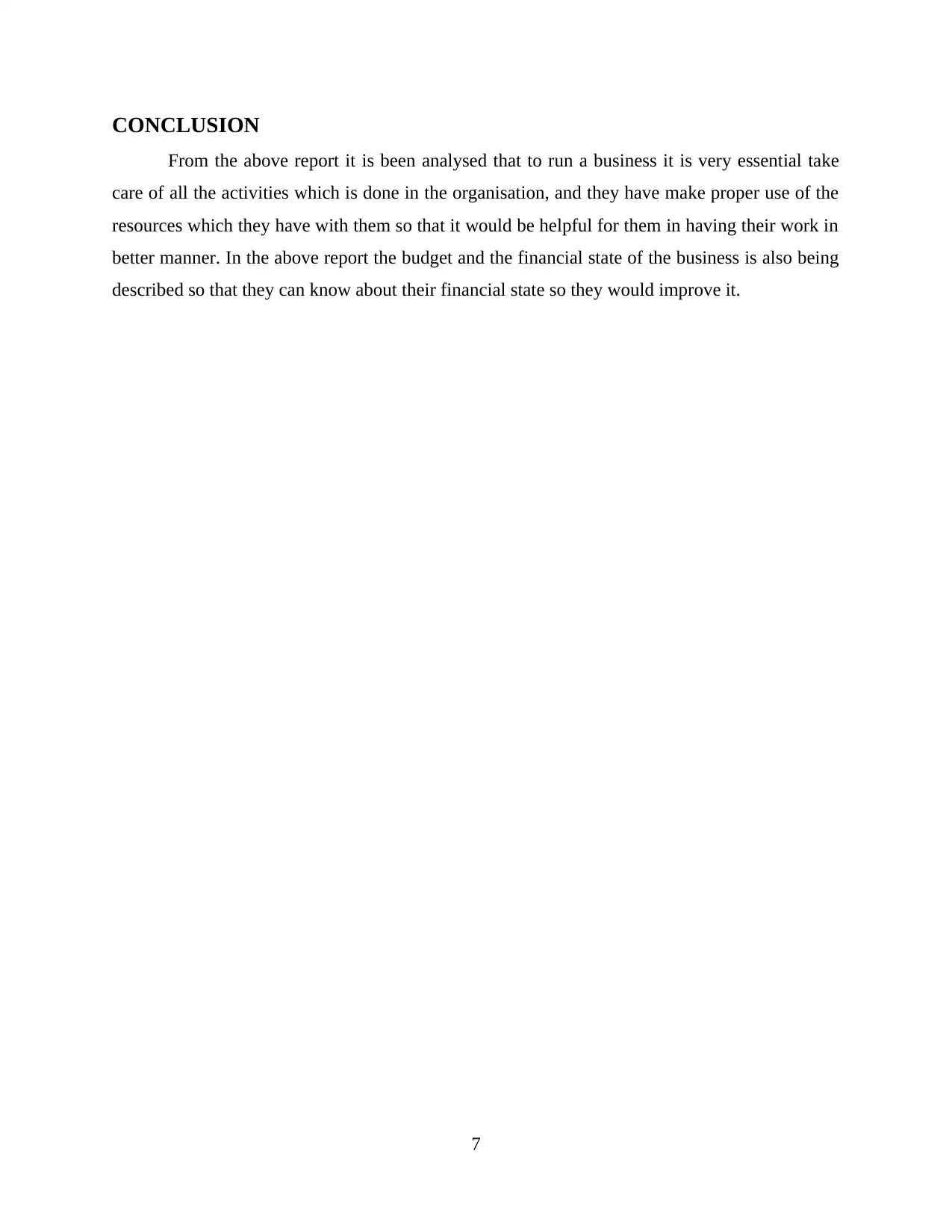
CONCLUSION
From the above report it is been analysed that to run a business it is very essential take
care of all the activities which is done in the organisation, and they have make proper use of the
resources which they have with them so that it would be helpful for them in having their work in
better manner. In the above report the budget and the financial state of the business is also being
described so that they can know about their financial state so they would improve it.
7
From the above report it is been analysed that to run a business it is very essential take
care of all the activities which is done in the organisation, and they have make proper use of the
resources which they have with them so that it would be helpful for them in having their work in
better manner. In the above report the budget and the financial state of the business is also being
described so that they can know about their financial state so they would improve it.
7
⊘ This is a preview!⊘
Do you want full access?
Subscribe today to unlock all pages.

Trusted by 1+ million students worldwide
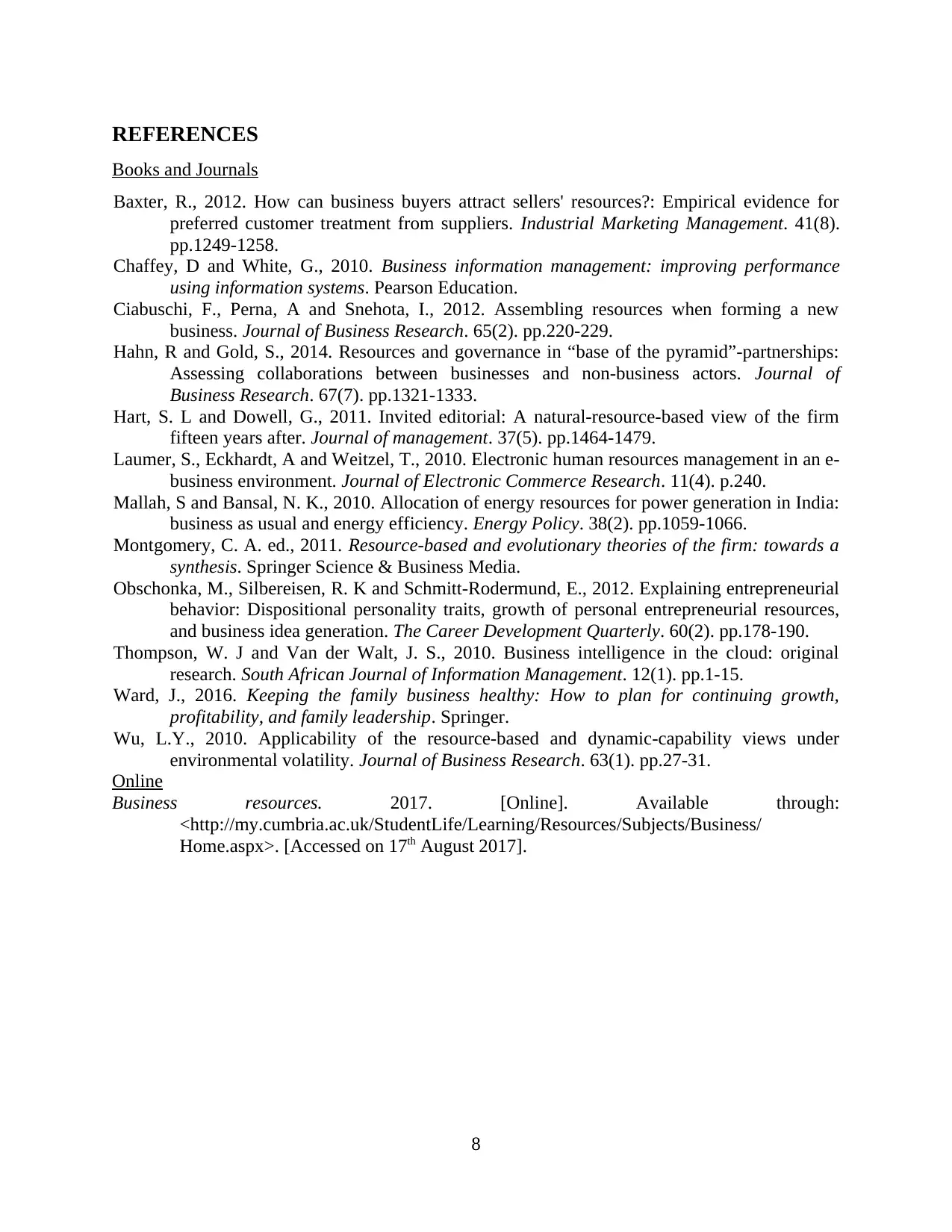
REFERENCES
Books and Journals
Baxter, R., 2012. How can business buyers attract sellers' resources?: Empirical evidence for
preferred customer treatment from suppliers. Industrial Marketing Management. 41(8).
pp.1249-1258.
Chaffey, D and White, G., 2010. Business information management: improving performance
using information systems. Pearson Education.
Ciabuschi, F., Perna, A and Snehota, I., 2012. Assembling resources when forming a new
business. Journal of Business Research. 65(2). pp.220-229.
Hahn, R and Gold, S., 2014. Resources and governance in “base of the pyramid”-partnerships:
Assessing collaborations between businesses and non-business actors. Journal of
Business Research. 67(7). pp.1321-1333.
Hart, S. L and Dowell, G., 2011. Invited editorial: A natural-resource-based view of the firm
fifteen years after. Journal of management. 37(5). pp.1464-1479.
Laumer, S., Eckhardt, A and Weitzel, T., 2010. Electronic human resources management in an e-
business environment. Journal of Electronic Commerce Research. 11(4). p.240.
Mallah, S and Bansal, N. K., 2010. Allocation of energy resources for power generation in India:
business as usual and energy efficiency. Energy Policy. 38(2). pp.1059-1066.
Montgomery, C. A. ed., 2011. Resource-based and evolutionary theories of the firm: towards a
synthesis. Springer Science & Business Media.
Obschonka, M., Silbereisen, R. K and Schmitt‐Rodermund, E., 2012. Explaining entrepreneurial
behavior: Dispositional personality traits, growth of personal entrepreneurial resources,
and business idea generation. The Career Development Quarterly. 60(2). pp.178-190.
Thompson, W. J and Van der Walt, J. S., 2010. Business intelligence in the cloud: original
research. South African Journal of Information Management. 12(1). pp.1-15.
Ward, J., 2016. Keeping the family business healthy: How to plan for continuing growth,
profitability, and family leadership. Springer.
Wu, L.Y., 2010. Applicability of the resource-based and dynamic-capability views under
environmental volatility. Journal of Business Research. 63(1). pp.27-31.
Online
Business resources. 2017. [Online]. Available through:
<http://my.cumbria.ac.uk/StudentLife/Learning/Resources/Subjects/Business/
Home.aspx>. [Accessed on 17th August 2017].
8
Books and Journals
Baxter, R., 2012. How can business buyers attract sellers' resources?: Empirical evidence for
preferred customer treatment from suppliers. Industrial Marketing Management. 41(8).
pp.1249-1258.
Chaffey, D and White, G., 2010. Business information management: improving performance
using information systems. Pearson Education.
Ciabuschi, F., Perna, A and Snehota, I., 2012. Assembling resources when forming a new
business. Journal of Business Research. 65(2). pp.220-229.
Hahn, R and Gold, S., 2014. Resources and governance in “base of the pyramid”-partnerships:
Assessing collaborations between businesses and non-business actors. Journal of
Business Research. 67(7). pp.1321-1333.
Hart, S. L and Dowell, G., 2011. Invited editorial: A natural-resource-based view of the firm
fifteen years after. Journal of management. 37(5). pp.1464-1479.
Laumer, S., Eckhardt, A and Weitzel, T., 2010. Electronic human resources management in an e-
business environment. Journal of Electronic Commerce Research. 11(4). p.240.
Mallah, S and Bansal, N. K., 2010. Allocation of energy resources for power generation in India:
business as usual and energy efficiency. Energy Policy. 38(2). pp.1059-1066.
Montgomery, C. A. ed., 2011. Resource-based and evolutionary theories of the firm: towards a
synthesis. Springer Science & Business Media.
Obschonka, M., Silbereisen, R. K and Schmitt‐Rodermund, E., 2012. Explaining entrepreneurial
behavior: Dispositional personality traits, growth of personal entrepreneurial resources,
and business idea generation. The Career Development Quarterly. 60(2). pp.178-190.
Thompson, W. J and Van der Walt, J. S., 2010. Business intelligence in the cloud: original
research. South African Journal of Information Management. 12(1). pp.1-15.
Ward, J., 2016. Keeping the family business healthy: How to plan for continuing growth,
profitability, and family leadership. Springer.
Wu, L.Y., 2010. Applicability of the resource-based and dynamic-capability views under
environmental volatility. Journal of Business Research. 63(1). pp.27-31.
Online
Business resources. 2017. [Online]. Available through:
<http://my.cumbria.ac.uk/StudentLife/Learning/Resources/Subjects/Business/
Home.aspx>. [Accessed on 17th August 2017].
8
1 out of 10
Related Documents
Your All-in-One AI-Powered Toolkit for Academic Success.
+13062052269
info@desklib.com
Available 24*7 on WhatsApp / Email
![[object Object]](/_next/static/media/star-bottom.7253800d.svg)
Unlock your academic potential
Copyright © 2020–2025 A2Z Services. All Rights Reserved. Developed and managed by ZUCOL.





